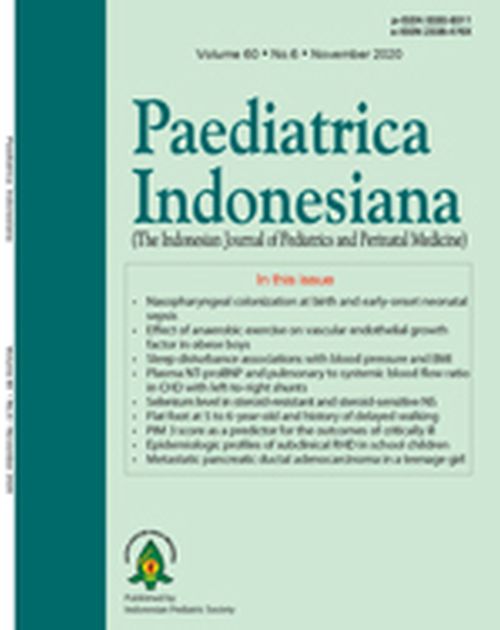Selenium level in steroid-resistant and steroid-sensitive nephrotic syndrome
Abstract
Background The mechanisms of pathogenesis of steroid-resistant nephrotic syndrome (SRNS) and steroid-sensitive nephrotic syndrome (SSNS) are not well understood. Antioxidants, such as glutathione peroxidase enzyme (GPx) and its cofactor, selenium, are thought to slow the progress of nephrotic syndrome (NS).
Objective To compare selenium levels in SRNS and SSNS pediatric patients.
Methods This cross-sectional study was conducted in 51 SRNS and 30 SSNS patients, aged 2 to 18 years, who visited the Pediatric Nephrology Outpatient Clinic at Cipto Mangunkusumo Hospital, Jakarta. Subjects were included by consecutive sampling. Selenium was measured on venous blood using GC tools MS â„¢ (Agilent technologies, inc.).
Results Median selenium levels in SRNS patients were 92 (range 42-154) μg/L and in SSNS patients were 93 (range 69-193) μg/L.
Conclusion Selenium levels in SRNS and SSNS patients were not significantly different.
References
2. Trihono PP, Alatas H, Tambunan T, Pardede SO. Konsensus tata laksana sindrom nefrotik idiopatik pada anak. 2nd ed. Jakarta: Badan Penerbit Ikatan Dokter Anak Indonesia; 2012. p. 1-20.
3. Lane JC. Pediatric nephrotic syndrome. 2015 Aug 6;[cited 2016 April 24]. Available from: http://emedicine.medscape.com/article/982920-overview.
4. Moustafa BH, Tolba OA. Immunosuppressive therapy in children with steroid-resistant, frequently-relapsing, and steroid-dependent idiopathic nephrotic syndrome: a single center experience. Electron Physician. 2016;8:2039-47. DOI: 10.19082/2039.
5. Kaneko K. Pathogenesis in childhood idiopathic nephrotic syndrome: an update of patchwork. Curr Pediatr Rev. 2009;5:56-64. DOI: 10.2174/157339609787587537.
6. Niaudet P. Steroid-sensitive idiopathic nephrotic syndrome in children. In: Avner ED, Harmon WE, Niaudet P, editors. Pediatric Nephrology. 5th ed. Philadelphia: Lippincott Williams & Wilkins; 2004. p. 543-56.
7. Bakker WW, van Luijk WH. Do circulating factors play a role in the pathogenesis of minimal change nephrotic syndrome? Pediatr Nephrol. 1989;3:341-9. DOI: 10.1007/BF00858545.
8. Tulpar S, Gunduz Z, Sahin U, Hakan Poyrazoglu M, Dursun I, Dusunsel R, et al. Trace elements in children suffering from idiopathic nephrotic children. Eurasian J Med. 2014;46:187-91. DOI: 10.1007/BF00858545.
9. Mishra OP, Gupta AK, Prasad R, Ali Z, Upadhyay RS, Mishra SP, et al. Antioxidant status of children with idiopathic nephrotic syndrome. Pediatr Nephrol. 2011;26:251–6. DOI: 10.1007/s00467-010-1696-6.
10. Fydryk J, Olszewska M, Urasi´nski T, Brodkiewicz A. Serum selenium level and glutathione peroxidase activity in steroid-sensitive nephrotic syndrome. Pediatr Nephrol. 2003;18:1063-5. DOI: 10.1007/s00467-003-1237-7.
11. Kidney Disease: Improving Global Outcomes (KDIGO) CKD Work Group. KDIGO 2012 Clinical practice guideline for the evaluation and management of chronic kidney disease. Kidney Int Suppl. 2013;3:1-150. DOI: 10.1038/kisup.2012.77.
12. Arup laboratories. Selenium serum or plasma. 2019; [cited 2020 January 7]; Available from: https://ltd.aruplab.com/Tests/Pub/0025023.
13. Gauthier B, Trachtman H. Pharmacological treatment of nephrotic syndrome. Drugs Today. 1999;35:13-26. DOI: 10.1358/dot.1999.35.1.522942.
14. Mitsui T, Umaki Y, Nagasawa M, Akaike M, Aki K, Azuma H, et al. Mitochondrial damage in patients with long-term corticosteroid therapy: development of oculoskeletal symptoms similar to mitochondrial disease. Acta Neuropathol. 2002;104:260-6. DOI: 10.1007/s00401-002-0553-5.
15. Handy DE, Loscalzo J. Redox regulation of mitochondrial function. Antioxid Redox Signal. 2012;16:1323-67. DOI: 10.1089/ars.2011.4123.
16. Du J, McEwen B, Manji HK. Glucocorticoid receptors modulate mitochondrial function: a novel mechanism for neuroprotection. Commun Integr Biol. 2009;2:350-2. DOI: 10.4161/cib.2.4.8554.
17. Marano G, Fischioni P, Graziano C, Iannone M, Morisi G. Increased serum selenium levels in patients under corticosteroid treatment. Pharmacol Toxicol. 1990;67:120-2. DOI: 10.1111/j.1600-0773.1990.tb00796.x.
18. Nourbakhsh N, Mak RH. Steroid-resistant nephrotic syndrome: past and current perspectives. Pediatric Health Med Ther. 2017;8:29–37. DOI: 10.2147/PHMT.S100803.
19. Tullus K, Webb H, Bagga A. Management of steroid-resistant nephrotic syndrome in children and adolescents. Lancet Child Adolesc Health. 2018;2:880-90. DOI: 10.1016/S2352-4642(18)30283-9.
20. Kumar D, Arya P, Sharma IK, Singh MV. Effect of zinc therapy in remission of pediatric nephrotic syndrome. Int J Contemp Pediatr. 2017;4:2036-40. DOI: 10.18203/2349-3291.ijcp20174726.
21. Arun S, Bhatnagar S, Menon S, Saini S, Hari P, Bagga A. Efficacy of zinc supplements in reducing relapses in steroid-sensitive nephrotic syndrome. Pediatr Nephrol. 2009;24:1583-6. DOI: 10.1007/s00467-009-1170-5.
Copyright (c) 2020 andini striratnaputri, Sudung Oloan Pardede, Muzal Kadim

This work is licensed under a Creative Commons Attribution-NonCommercial-ShareAlike 4.0 International License.
Authors who publish with this journal agree to the following terms:
Authors retain copyright and grant the journal right of first publication with the work simultaneously licensed under a Creative Commons Attribution License that allows others to share the work with an acknowledgement of the work's authorship and initial publication in this journal.
Authors are able to enter into separate, additional contractual arrangements for the non-exclusive distribution of the journal's published version of the work (e.g., post it to an institutional repository or publish it in a book), with an acknowledgement of its initial publication in this journal.
Accepted 2020-11-23
Published 2020-11-23













